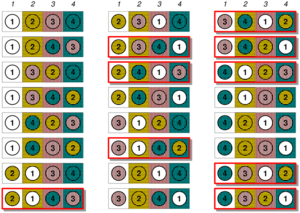Derangement (nonfiction): Difference between revisions
(Created page with "thumb|All 24 permutations of 4 elements, with highlighting of the 9 derangements.In combinatorial mathematics, a '''derangement''' is a permutation...") |
No edit summary |
||
| (One intermediate revision by the same user not shown) | |||
| Line 6: | Line 6: | ||
The problem of counting derangements was first considered by [[Pierre Raymond de Montmort (nonfiction)|Pierre Raymond de Montmort]] in 1708; he solved it in 1713, as did [[Nicholas Bernoulli (nonfiction)|Nicholas Bernoulli]] at about the same time. | The problem of counting derangements was first considered by [[Pierre Raymond de Montmort (nonfiction)|Pierre Raymond de Montmort]] in 1708; he solved it in 1713, as did [[Nicholas Bernoulli (nonfiction)|Nicholas Bernoulli]] at about the same time. | ||
== Generalizations == | |||
=== Roblème des rencontres === | |||
The [[Rencontres numbers (nonfiction)|problème des rencontres]] asks how many permutations of a size-n set have exactly k fixed points. | |||
=== Anagrams === | |||
Another generalization is the following problem: | |||
How many anagrams with no fixed letters of a given word are there? | |||
== In the News == | == In the News == | ||
| Line 13: | Line 25: | ||
== Fiction cross-reference == | == Fiction cross-reference == | ||
* [[Crimes against mathematical constants]] | |||
* [[Gnomon algorithm]] | |||
* [[Gnomon Chronicles]] | |||
* [[Mathematician]] | |||
* [[Mathematics]] | |||
== Nonfiction cross-reference == | == Nonfiction cross-reference == | ||
| Line 19: | Line 37: | ||
* [[Nicholas Bernoulli (nonfiction)]] | * [[Nicholas Bernoulli (nonfiction)]] | ||
* [[Pierre Raymond de Montmort (nonfiction)]] | * [[Pierre Raymond de Montmort (nonfiction)]] | ||
* [[Rencontres numbers (nonfiction)]] - a Triangular array (nonfiction)|triangular array]] of [[Integer (nonfiction)|integers]] that enumerate permutations of the set { 1, ..., ''n'' } with specified numbers of fixed points: in other words, partial derangements. | |||
External links: | External links: | ||
Latest revision as of 14:23, 28 October 2019
In combinatorial mathematics, a derangement is a permutation of the elements of a set, such that no element appears in its original position. In other words, derangement is a permutation that has no fixed points.
The number of derangements of a set of size n, usually written Dn, dn, or !n, is called the "derangement number" or "de Montmort number". (These numbers are generalized to rencontres numbers.) The subfactorial function (not to be confused with the factorial n!) maps n to !n.
No standard notation for subfactorials is agreed upon; n¡ is sometimes used instead of !n.
The problem of counting derangements was first considered by Pierre Raymond de Montmort in 1708; he solved it in 1713, as did Nicholas Bernoulli at about the same time.
Generalizations
Roblème des rencontres
The problème des rencontres asks how many permutations of a size-n set have exactly k fixed points.
Anagrams
Another generalization is the following problem:
How many anagrams with no fixed letters of a given word are there?
In the News
Fiction cross-reference
Nonfiction cross-reference
- Mathematics (nonfiction)
- Nicholas Bernoulli (nonfiction)
- Pierre Raymond de Montmort (nonfiction)
- Rencontres numbers (nonfiction) - a Triangular array (nonfiction)|triangular array]] of integers that enumerate permutations of the set { 1, ..., n } with specified numbers of fixed points: in other words, partial derangements.
External links:
- Derangement @ Wikipedia
